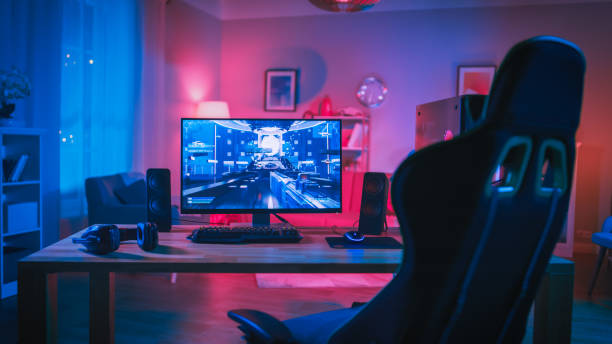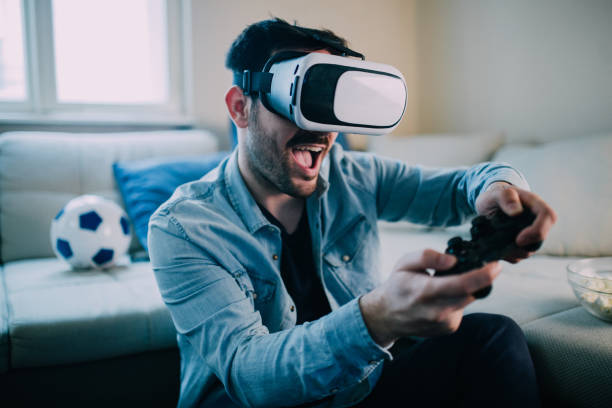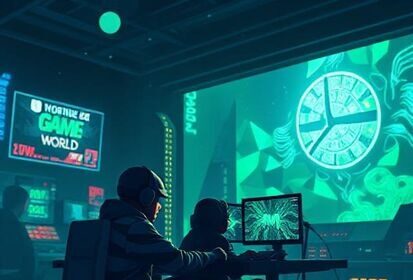Virtual Reality in Gaming
Imagine entering a universe where dragons fly overhead, galaxies unfold before you, and your living room is a battlefield. Sound like science fiction? Reconsider—it’s your virtual reality of today. But here’s the irony: even though VR seems like the next big step in gaming, some experts believe it’s just a passing fad. So, is VR gaming the revolution we’ve been sold, or will it gather dust right alongside last decade’s 3D TVs?
Let’s get into it — and see what’s really going down in the world of VR gaming.
What Is Virtual Reality Gaming, Exactly?

Virtual Reality (VR) gaming is not merely putting on a headset — it is about immersing yourself into a game rather than playing it. Utilizing motion sensors, spatial audio and hand-tracking controllers, VR dives players into 360-degree settings where your body is the controller.
Touch: You don’t hit a button to swing a sword — you swing it. The boundary between actual and simulated? Blurred.
And it doesn’t only have to be games like Beat Saber or Half-Life: Alyx that are pushing boundaries. The stifling, oppressive experiences are incredibly intense and visceral, but even calm experiences such as Moss (a light-hearted storybook platformer starring a tiny mouse) is packed full of emotion and depth you never thought existed in a game.
Are VR Gaming Experiences Well Buzzed?
Let’s talk science. VR is not simply a novelty—it stimulates cognitive immersion. As reported in Frontiers in Psychology, VR can elicit enhanced emotional and memory responses compared to more traditional media. In other words, what occurs in VR doesn’t just seem real — it sticks.
And then there’s the neurological piece. The brain treats VR interactions in ways close to real-life interactions, creating a feedback loop that further improves both engagement and retention.
That’s also why companies like Meta, Sony and Apple are plowing billions into the VR race. This isn’t play money — it’s a war for the next computing platform.
The Down to Earth Effect: Not Just Hot Air

Let’s get real for a second. VR has already revolutionized our approach to gaming. Take Resident Evil 4 VR, which reimagined a classic horror game as a visceral, pulse-pounding experience unlike any other. Or consider No Man’s Sky, where the act of exploring alien worlds in VR boils down to the experience of real space travel.
The global VR gaming market could grow to $92.3 billion by 2027, Grand View Research reported in 2024. With the release of Apple Vision Pro and PSVR2, we can see AAA devs getting serious about native VR titles, not just adaptations.
These are no longer niche experiences. They’re mainstream movements.
But Wait… Is This Just a VR Fad?
Here’s where it gets tricky. Sure, VR hardware is still pricey and somewhat awkward. And yes, not all people have the space or appetite for intense motion-based games.
Also, remind yourselves: other tech “next big things” (cough Google Glass) have been duds.
But here’s the key differentiator: VR is already addressing those problems. That’s the Meta Quest 3, a wireless, standalone mixed reality headset. Sony’s PSVR2 introduces next-generation haptics and eye-tracking to living rooms across the globe.
And developers are honing their approach. The emphasis is shifting toward comfort, accessibility, and replayability, which enables VR gaming to become something you can experience daily rather than just on occasion.
Expert Take: What the Experts Are Saying
As Jesse Schell — a celebrated game designer and author of The Art of Game Design — once said, “VR isn’t a fad — it’s a new medium. Just as film changed theater, VR is changing games.”
Oculus founder Palmer Luckey, for his part, remarked, “We’ve only begun to scratch the surface. The next era of gaming isn’t on a screen — it’s all around you.”
These aren’t optimistic predictions. They are guides to the future.
VR In The Hands Of Gamers: The Player Perspective
According to a recent survey by IGN, 64% of VR headset owners use their devices at least once each week, while several say that VR makes traditional gaming feel “flat” when compared.
Communities like r/virtualreality and VRChat also continue to flourish, with user-generated content, mods, and shared experiences.
Oh, and let’s not forget the growth of VR esports — with titles such as Echo VR and Onward having entire competitive circuits complete with fans and cash prizes.
The community is no longer some fringe group — it’s a passionate, flourishing ecosystem.
What’s Next for VR Gaming?
The next 2–5 years should see huge growth. With cloud rendering, AI-driven NPCs and full-body tracking just around the corner, VR games are set to become more realistic, responsive and expansive than ever.
Think of a game with biometrics that know your feelings. Or one that’s shaped in real time, depending on what you do. That’s no longer science fiction — it’s being developed.
There are studios like Valve, Ubisoft, and even indie devs, that are building worlds beyond the confines of 2D; and you’d have to feel it to believe it — you have to try it to really understand.
So, Future or Fad?
Let’s get this out of the way: Virtual reality has come to gaming to stay — and it’s the start of a paradigm shift.
Yes, there are growing pains. But every great tech revolution began with skepticism — from smartphones to streaming. Now VR is going down the same road. But it is not merely surviving — it is thriving.
The only true question is: Will you make it?
Are You Ready to Enter a New World?
If you haven’t yet tried VR gaming, now is a great time to do so. One session, whether on a basic headset like the Meta Quest 2 or a high-end PC VR setup, is at the end of the day enough to leave your mind blown.
So come on–put on that headset, load up a world, and experience the future of gaming for yourself.
Because the next level of gaming? It’s not only on your screen — it’s everywhere around you.








